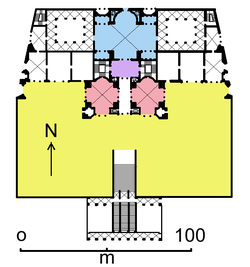Baths of Titus
Coordinates: 41°53′33.20″N 12°29′38.59″E / 41.8925556°N 12.4940528°E

.jpg)
The Baths of Titus or Thermae Titi were public baths (Thermae) built in Rome in 81 by Emperor Titus.[1] The baths sat at the base of the Esquiline Hill, an area of parkland and luxury estates which had been taken over by Nero (AD 54–68) for his Golden House or Domus Aurea. Thermae Titi or Titus' baths were built in haste, possibly by converting an existing or partly built bathing complex belonging to the reviled Domus Aurea.[2] They were not particularly extensive, and the much larger Baths of Trajan were built immediately adjacent to them at the start of the next century.[3]
The Baths of Titus were restored during the reign of Hadrian as well as in AD 238 but no further repairs are known.[4][5] It is thus likely that the entire complex underwent a process of early abandonment. Large parts of the building were still standing in the 16th century when Andrea Palladio described the floor plan. The ruins were demolished shortly afterwards, their marble and building materials being reused for the building of palaces and churches such as the side chapels of the Church of the Gesù or the fountain of the Cortile del Belvedere in the Vatican.
One of the features of the baths was mural designs by the artist Famulus (or Fabullus), both al fresco and al stucco. Before the designs fell into disrepair from exposure to the elements, Nicholas Ponce copied and reproduced them as engravings in his volume "Description des bains de Titus" (Paris, 1786). The designs are now recognized as a source of the style known as "grotesque" (meaning "like a small cave, a hollow, a grotto") because the ruins of the Baths of Titus were in a hollow in the ground when they were discovered.[6]
See also
References
| Wikimedia Commons has media related to Baths of Titus. |
- ↑ Suet. Titus 7 http://latin.packhum.org/loc/1348/1/0#229
- ↑ Frank Sear (1983). Roman Architecture. Cornell University Press. pp. 145–. ISBN 0-8014-9245-9.
- ↑ American Architect and Architecture. J. R. Osgood & Company. 1900. pp. 27–.
- ↑ Hist. Aug. Max. et Balb. I
- ↑ CIL 6.9797
- ↑ Lecture 12 - The Creation of an Icon: The Colosseum and Contemporary Architecture in Rome as author at YALE HSAR 252 - Roman Architecture with Professor Diana E. E. Kleiner.